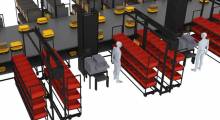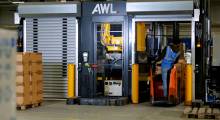Commercial robotic systems need not be complicated, expensive, or take up valuable floor space in perpetuity. Some robots are small, but mighty - providing adaptable and scalable options without sacrificing flexibility or breaking the bank.
Tompkins Robotics develops and markets a wide range of warehouse robots, including its flagship tSort system. The growing family of tSort autonomous mobile robots (AMRs) and their relatives, coupled with the company’s Transcend platform, can provide flexible and scalable sortation for a variety of applications.
Simple robots enable commercial viability
Robotics 24/7 readers might have noted two similar company pages on our website: Tompkins Robotics and Tompkins Solutions. Their resemblance is no coincidence.
Mike Futch, Tompkins Robotics president and CEO, said the Tompkins International board voted to split into two independent companies, effective Jan. 1, 2021. Tompkins Solutions is the legacy consulting and integration side of the business, while Tompkins Robotics concentrates on developing products.
“We're a product company. We make and sell software and robots,” Futch said. “A lot of our leadership are ex-consultants and people from industry who really understand logistics and supply chain distribution.”
Leveraging the experience of its team, Tompkins Robotics has designed its robots to meet industry needs.
“You need to find problems that need real-world solutions and then craft a robotic solution to meet that,” Futch said. “We've built technologies, applications, software, and hardware to address real-world concerns and problems in a unique way.”
One differentiator for Tompkins Robotics is its relatively simple tSort AMRs.
“If you open up one of these robots, there's only 14 components,” Futch said. “If you make it too sophisticated, too expensive, you price yourself out of a good ROI and commercial viability.”
Tompkins’ tSort system is flexible, modular, portable, and scalable
Tompkins Robotics’ tSort is a flexible sortation system designed to handle small parcels and individual items. AMRs operate on tabletop platforms, sorting loads into bins along the periphery.
“If you think about traditional sortation systems - whether that be a crossbelt, a tilt tray, a bomb bay - there's a lot of steel,” Futch said. “It's bolted to the floor. You have to permit it. You have to put sprinklers underneath it. It requires hardwired electrical. The infrastructure costs are greater.
“With our system, it's flexible, modular, scalable, even portable,” he said. “Nothing bolts to the floor. Everything is on wheels - even the platforms you see the robots running on are on wheels.”
Tompkins Robotics’ tSort systems can plug into standard 110 volt outlets to collect power for robot charging.

Without the tethers of more traditional fixed automation systems - sometimes referred to as monuments or monoliths because they are immovable within a facility - tSort customers can adapt and expand their systems through a “buy-as-you-go” business model. Futch said customers can integrate system expansions in as little as an hour.
“It's a whole different mindset, technology, and flexibility - a game changer compared to the traditional sortation systems of the past,” he said.
Applications of the tSort system include store replenishment, ecommerce fulfillment, reverse logistics, parcel sortation, microfulfillment, order picking, kitting, and other goods-to-person operations.
Expanding destinations and functions with tStort3D, tSortLift
Tabletop robotics can provide simple and flexible small item and parcel sortation. Now add a vertical element.
Tompkins Robotics’ tSort3D is a robotic crane that can sort items into containers like a miniature put wall. The module only takes up six spaces alongside a tSort table, but it can add as many as 60 destinations, depending on container size.
“This is a way for us to get higher density and more sort destinations in a smaller footprint than we would normally with either the tSortPost or our traditional tSort applications,” Futch said. Applications for tSort3D include e-commerce and prescription pharmaceutical sortation, among others.

But wait, tSort can rise even higher: Futch also described a multi-function sorter where item sortation is performed on a lower level, with packed order shipping sortation stacked on top.
Operators pick completed orders from tSort3D, which serves as an order consolidation point. Items are packed through an automated bagger, then pass along a conveyor to a tSortLift elevator, which hands it off to a tSort AMR on the upper level for shipping sortation.
“Instead of those being two separate operations, we've consolidated them in one infrastructure to save space and touches,” Futch said. “That will fully automate the entire process - from induction through shipping to the end destination.”
“A lot of our innovation is sparked by touches,” said Bill Pelzar, Tompkins Robotics CTO. “Wherever there's a manual touch or a manual process, Mike and our other engineers have come up with innovative ways to automate those steps, which generally leads to an innovative product enhancement, or sometimes a new product.”
New tSortPost pedestal AMR enables adaptable mobile deployment
With its latest addition to the tSort family, end users don’t even need a full tSort tabletop system. Tompkins Robotics recently announced its tSortPost pedestal AMR. Futch said Tompkins Robotics differentiates its pedestal AMR from other vendors in three ways:
- An adjustable post height
- Divert mechanisms include both a cross belt or a tilt tray
- A scissor lift option for sortation at multiple heights
While normal tSort systems are designed for volumes of 10,000 to 20,000 items per hour, tSortPost is designed for applications that handle 1,000 to 5,000 items per hour.
“If you can do that without the cost and the space of the tables, you just lowered the cost and increased the ROI for that application,” Futch said.
Applications for tSortPost include conveyance and vehicle loading at last-mile delivery hubs.
“The robots can just be rolled onto a truck for relocation,” Futch said. “If you need to pick up and move three months later to another location, you can do it.”
“We're hoping it's going to be a gateway product,” Pelzar said. “Somebody can start with our pedestal, and if they like it, and they like Tompkins, and they see the value in it, they may purchase a tSort, xChange, PickPal, or other system from Tompkins.”
Transcend software built from modular micro services
On top of its robots, Tompkins Robotics’ Transcend robotics execution software platform keeps the robots moving. Pelzar said the software comprises multiple layers:
- Transcend Control: a robot control system (RCS) onboard each robot
- Transcend Connect: an integration layer for fleet management
- Transcend Orchestrate: a system that handles customer workflow orchestration
- A visibility layer: User interfaces, including the Transcend Mobile app, control panels, and/or dashboards

Unlike a monolithic code block with interdependent services, the layers of Transcend are modular micro services that can be configured to connect with different products and warehouse management systems (WMS) across different environments. Pelzar said Tompkins Robotics can deploy Transcend software locally on premises, in the cloud, or even as a hybrid.
“The software has to adapt in kind with the way the hardware is,” Pelzar said. “If a customer has a bias toward one sort of deployment model, we can go whatever direction they want to go.
“We have one code base, so the software we deploy in the cloud is the same we deploy on premises,” he added.
Transcend is sold as a subscription through a software-as-a-service (SaaS) model. Pelzar said the software is constantly being updated as research and development continues, passing along benefits to customers.
AI and ML could deliver valuable insights in the future
Tompkins Robotics can also provide its customers with analytics to show how its products are meeting their business needs.
“They can come back to us, and ask us to do different things down the line,” Pelzar said. “So what it does today isn't limited in perpetuity.”
In the future, AI and machine learning could interpret insights from the enterprise data warehouse (EDW) data sets Tompkins Robotics is already collecting.
“We see value in the data that we're generating and capturing,” Pelzar said. “Data mining could be of value to customers to help them improve their operations.
“Instead of just doing tasks that we've been asked to do relative to the robotics solutions that we've provided, we now may be able to offer back to them insights into their operations to help our customers improve their operations going forward,” he added. “That's the future that we see.”
Want to learn more about robots picking, packing and packaging? This article was featured in the October 2024 Robotics 24/7 Special Focus Issue titled “Robots picking and packing with precision.”
Tompkins Robotics multi-function sorter
The tSort3D and tSortLift can help enable higher density sortation operations.About the Author
Follow Robotics 24/7 on Linkedin
Article topics
Email Sign Up


















